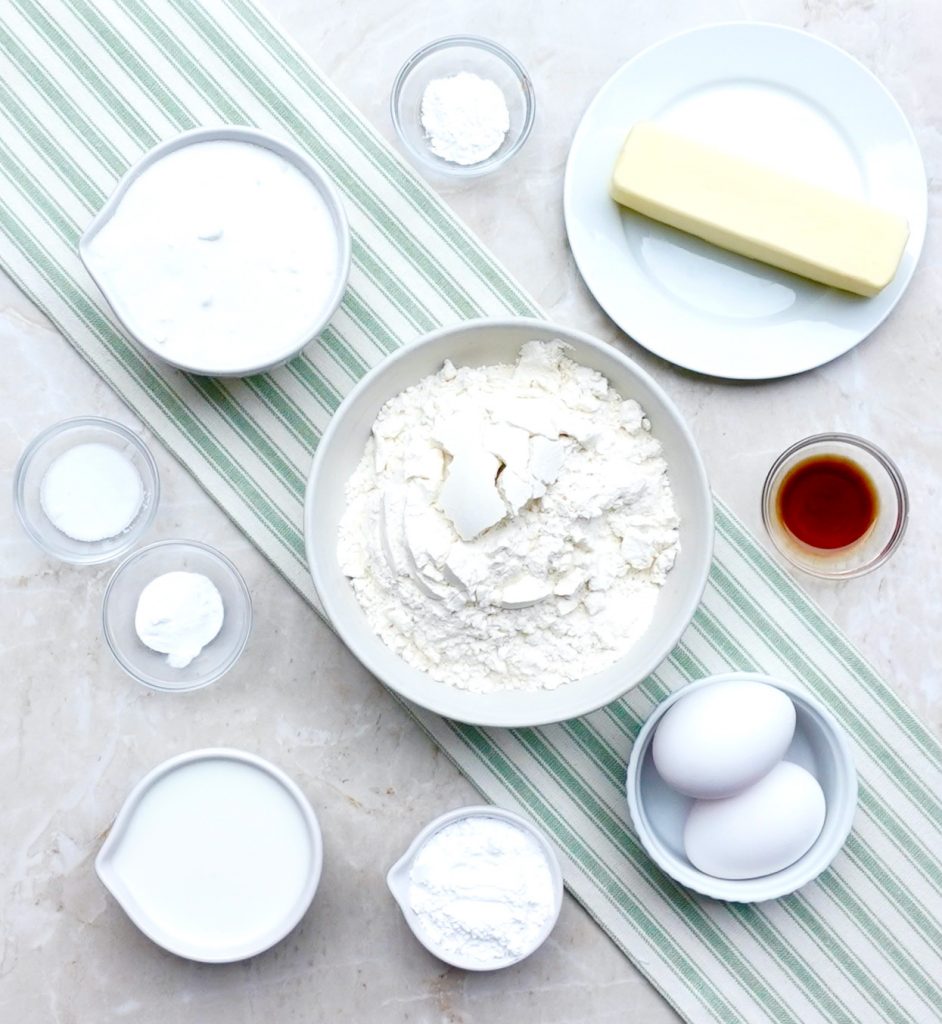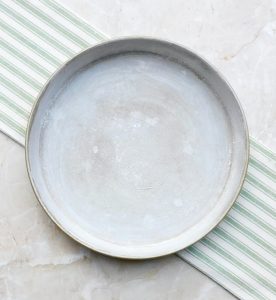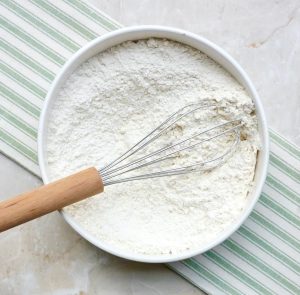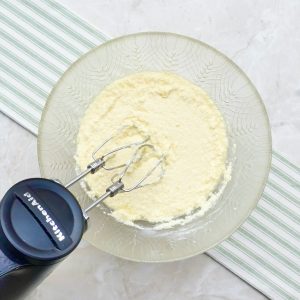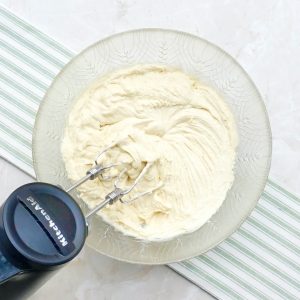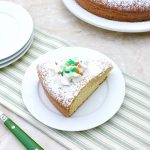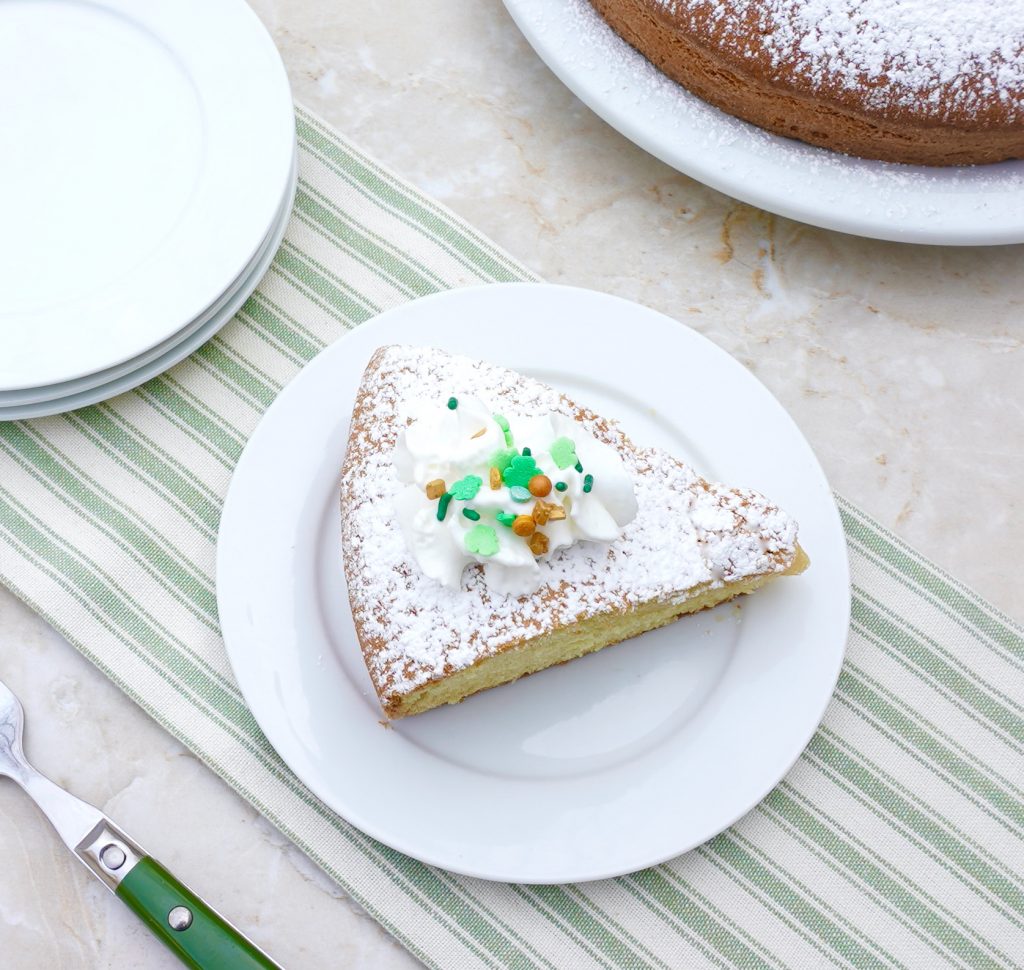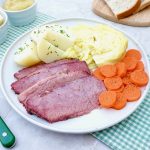Irish Tea Cake is a simple cake that is light, moist and delicious. It is a traditional Irish cake recipe that is typically served for afternoon tea. While it is the perfect pairing for a hot cup of tea any time of year, it would also make a great St. Patrick’s Day dessert. It has a nice vanilla flavor and a light sprinkle of powdered sugar on the top of the cake.
If you would like to do some other baking for St Patrick’s day, check out Chocolate Guinness Cake and Irish Soda Bread. You might want to try Baileys Irish Cream Frosting to top your favorite cake.
If you are looking for some St. Patrick’s Day dinner ideas, check out Corned Beef Cabbage Dinner, Guinness Beef Stew and Bangers and Mash.
SOME THINGS TO KNOW: FAQ’S
INGREDIENT TIPS:
- Room temperature eggs mix more evenly into your batter, ensuring a uniform texture in the finished cake. You can bring eggs to room temperature quickly by placing them in a bowl of warm water for about 10 minutes. Read Do You Really Need to Bake with Room Temperature Eggs?
- High quality pure vanilla extract can make a significant difference in flavor of the cake.
SPECIAL EQUIPMENT NEEDED:
- 9″ Round Cake Pan: This is the primary baking vessel for your cake. If you don’t have a 9″ round pan, you can use a 9″ square pan.
- Mixing Bowls: You will need two mixing bowls for separating dry and wet ingredients before combining them. One larger bowl for the main mixture and a smaller one for sifting together the dry ingredients.
- Electric Mixer or Hand Mixer: While you can mix the batter by hand, using an electric mixer or a hand mixer makes the process easier, especially for creaming the butter and sugar until light and fluffy.
- Measuring Cups and Spoons: Accurate measurements are crucial in baking. You will need measuring cups for both liquid and dry ingredients, as well as measuring spoons for the smaller quantities of baking powder, baking soda, salt, and vanilla extract.
- Rubber Spatula or Wooden Spoon: For folding the dry ingredients into the wet mixture and ensuring that everything is well combined without over mixing.
- Wire Rack: After baking, you will need a wire rack to cool the cake completely before dusting it with powdered sugar. Cooling it on a rack prevents the bottom from becoming soggy.
- Sieve or Sifter for Powdered Sugar: To dust the cooled cake with powdered sugar, a small sieve or sifter is ideal for a light, even coating.
SUBSTITUTIONS:
- Powdered Sugar is granulated sugar that has been pulverized into a light powder. It may also have a bit of cornstarch added. This recipe calls for powdered sugar. Depending on where you live or what brand you buy, it can also be labeled as confectioners’ sugar, icing sugar and 10X. They are all the same. You can use any one of them. You can also make it yourself. Check out How to Make Powdered Sugar if you want to try this.
- The vanilla extract can be substituted with almond extract. Use half the amount, as almond extract is stronger. Vanilla bean paste can also be used in equal measure for a more intense vanilla flavor.
HOW TO STORE IRISH TEA CAKE:
- You can keep any leftover Irish Tea Cake for 1-2 days tightly covered or in an airtight container at room temperature.
HOW TO FREEZE IRISH TEA CAKE:
- You can freeze any leftover cake for 2-3 months in an airtight freezer container or covered in a layer of plastic wrap with an additional layer of aluminum foil.
- Defrost the frozen cake by placing it onto a wire rack at room temperature.
Prepare your cake pan.
Combine the flour, baking powder, baking soda and salt in a medium bowl and set aside.
Cream butter in a large bowl with an electric mixer at medium speed. Add the sugar and beat it into the butter until the mixture is pale yellow and fluffy.
Beat in the eggs, one at a time, mixing well after each addition. Add the vanilla extract and milk. Beat them into the butter mixture on low speed.
Add the flour mixture and beat it into the wet ingredients.
Spoon batter in the prepared pan. Place it in to the preheated oven on the top rack. Bake for 30-35 minutes
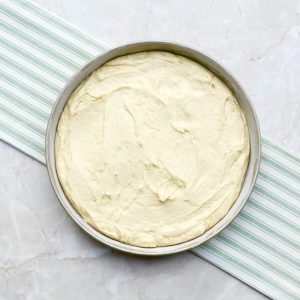
Irish Tea Cake
Print ThisIngredients
- 2 cups all purpose flour
- 1 teaspoon baking powder
- 1 teaspoon baking soda
- 1 teaspoon iodized salt
- 1 stick unsalted butter (½ cup butter at room temperature)
- 1 cup granulated sugar
- 2 large eggs (room temperature)
- 1 ½ teaspoons vanilla extract
- ½ whole milk
- ¼ cup powdered sugar
Instructions
Preheat the oven to 350 degrees
Prepare your cake pan. Lightly coat the interior of the pan with vegetable shortening. This is easily done with a paper towel. Add 2 teaspoons of flour to the pan and shake the pan so that the flour coats the entire surface. If you see any spots where the flour does not stick, add more shortening and then flour again.
Combine the flour, baking powder, baking soda and salt in a medium bowl and set aside.
Cream butter in a large bowl with an electric mixer at medium speed.
Add the sugar and beat it into the butter until the mixture is pale yellow and fluffy.
Beat in the eggs, one at a time, mixing well after each addition.
Add the vanilla extract and milk. Beat them into the butter mixture on low speed.
Add the flour mixture and beat it into the wet ingredients slowly at first to avoid the flour flying out of the bowl.
Mix until the ingredients are thoroughly combined but do not over beat the batter.
Spoon batter into the prepared pan.
Place it in to the preheated oven on the top rack.
Bake for 30-35 minutes. Oven temperatures vary. If your oven tends to run hot, start checking in on the cake before 30 minutes. You want the top top the cake to be completely set and light golden brown. You can insert a cake tester or toothpick into the center of the cake. If it comes out clean, then the cake is done.
Let the cake cool in the pan for 5 minutes then remove it from the pan and place it onto a wire rack to cool completely.
Once the cake has cooled to room temperature, remove it to a serving plate. Lightly sift the powdered sugar over the top of the cake.
To serve, you could add some whipped cream. Fresh berries and fresh fruit would also be a good addition.


